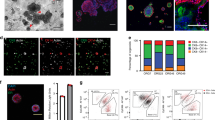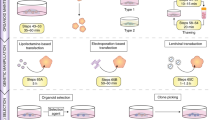Abstract
The MCF-7 line of human mammary carcinoma cells is a well characterised line1 which has retained a number of the properties expressed by breast epithelium in vivo, making it a good model for the in vitro study of normal and neoplastic mammary cells. MCF-7 cells have been reported to possess receptors for oestrogen, androgen, progesterone, glucocorticoid2, insulin3 and L-3, 3′, 5-triiodothyronine (T3)4. These cells also show responses to prolactin5, and dome formation1. This line, like most cells in culture, requires the addition of a serum supplement to the medium for growth. The complex and undefined nature of serum adds a complicating aspect to the design and interpretation of any experiments aimed at understanding the interactions of hormones or drugs with mammary epithelium. Our laboratory has shown that it is possible to replace the serum requirement for a number of cell lines with mixtures of hormones and purified serum factors6–8. We now report that MCF-7 cells may be grown, without a lag or adaptation phase, in a serum-free medium supplemented with physiological levels of insulin, transferrin, epidermal growth factor (EGF), prostaglandin F2α (PGF2α) and cold-insoluble globulin (CIg). This medium will support a growth rate identical to that of cells in medium supplemented with an optimal concentration of fetal calf serum. The further addition of the α-1 serum protein first purified by Holmes9 results in a morphology identical to that of cells in 10% serum. Turkington has previously shown EGF effects on mouse mammary expiant cultures10, and mouse EGF has been reported to be stimulatory for human mammary tumour cells . Insulin and transferrin have been shown to be required for the continuous serum-free growth of the ZR-75-1 human mammary tumour cell line12. We believe that this is the first report of the effects of transferrin, PGF2α, Clg, EGF or the α-1 protein on the MCF-7 line.
This is a preview of subscription content, access via your institution
Access options
Subscribe to this journal
Receive 51 print issues and online access
$199.00 per year
only $3.90 per issue
Buy this article
- Purchase on Springer Link
- Instant access to full article PDF
Prices may be subject to local taxes which are calculated during checkout
Similar content being viewed by others
References
Soule, H. D., Vazquez, J., Long, A., Albert, S. & Brennan, M. J. natl. Cancer Inst. 51, 1409–1413 (1973).
Horwitz, K. B., Costlow, M. E. & McGuire, W. L. Steroids 26, 785–795 (1975).
Osborne, C. K., Monaco, M. E., Lippman, M. E., Kahn, C. R. Cancer Res. 38, 94–102 (1978).
Burke, R. E. & McGuire, W. L. Cancer Res. 38, 3769–3773 (1978).
Shafie, S. & Brooks, S. C. Cancer Res. 37, 792–799 (1977).
Hayashi, I. & Sato, G. H. Nature 259, 132–134 (1976).
Hutchings, S. E. & Sato, G. H. Proc. natn. Acad. Sci. U.S.A. 75, 901–904 (1978).
Bottenstein, J. et al. Meth. Enzym. 58, 94–109 (1978).
Holmes, R. J. Cell Biol. 32, 297–308 (1967).
Turkington, R. W. Expl. Cell Res. 57, 79–85 (1969).
Stoker, M. G. P., Pigott, D. & Taylor-Papadimitriou, J. Nature 264, 764–767 (1976).
Allegra, J. C. & Lippman, M. E. Cancer Res. 38, 3823–3829 (1978).
Engel, L. W. & Young, N. A. Cancer Res. 38, 4327–4339 (1978).
Orly, J. & Sato, G. Cell 17, 295–305 (1979).
Rizzino, A. Fedn Proc. 38, 635 (1979).
Turner, M. W. & Hulme, B. The Plasma Proteins: An Introduction (Pitman, London, 1971).
Matsuda, M., Yoshida, N., Aoki, Y., Wakabayashi, K. Ann. N.Y. Acad. Sci. 312, 74–92 (1978).
Osborne, C. K., Bolan, G., Monaco, M. E. & Lippman, M. E. Proc. natn. Acad. Sci. U.S.A. 73, 4536–4540 (1976).
Lippman, M. E. & Bolan, G. Nature 256, 592–593 (1975).
Lippman, M. E., Bolan, G. & Huff, K. Nature 258, 339–341 (1975).
Zava, D. T. & McGuire, W. L. Science 199, 787–788 (1978).
Author information
Authors and Affiliations
Rights and permissions
About this article
Cite this article
Barnes, D., Sato, G. Growth of a human mammary tumour cell line in a serum-free medium. Nature 281, 388–389 (1979). https://doi.org/10.1038/281388a0
Received:
Accepted:
Published:
Issue Date:
DOI: https://doi.org/10.1038/281388a0
This article is cited by
-
Roles of vitamins in stem cells
Cellular and Molecular Life Sciences (2020)
-
Transferrin ensures survival of ovarian carcinoma cells when apoptosis is induced by TNFα, FasL, TRAIL, or Myc
Oncogene (2003)
-
Establishment and characterization of a novel in vitro angiogenesis model using a microvascular endothelial cell line, F-2C, cultured in chemically defined medium
In Vitro Cellular & Developmental Biology - Animal (1997)
-
Human breast cancer cell lines as models of growth regulation and disease progression
Journal of Mammary Gland Biology and Neoplasia (1996)
-
Continuous three-dimensional cultures of MCF-7 cells in serum free medium
In Vitro Cellular & Developmental Biology - Animal (1993)
Comments
By submitting a comment you agree to abide by our Terms and Community Guidelines. If you find something abusive or that does not comply with our terms or guidelines please flag it as inappropriate.



